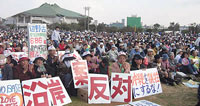
Follow workers.org on



RED HOT: TRAYVON MARTIN
CHINA,
AFGHANISTAN, FIGHTING RACISM, OCCUPY WALL STREET,
PEOPLE'S POWER, SAVE OUR POST OFFICES, WOMEN, AFRICA,
LIBYA, WISCONSIN WORKERS FIGHT BACK, SUPPORT STATE & LOCAL WORKERS,
EGYPT, NORTH AFRICA & MIDDLE EAST,
STOP FBI REPRESSION, RESIST ARIZONA RACISM, NO TO FRACKING, DEFEND PUBLIC EDUCATION, ANTI-WAR,
HEALTH CARE,
CUBA, CLIMATE CHANGE,
JOBS JOBS JOBS,
STOP FORECLOSURES, IRAN,
IRAQ, CAPITALIST CRISIS,
IMMIGRANTS, LGBT, POLITICAL PRISONERS,
KOREA,
HONDURAS, HAITI,
SOCIALISM,
GAZA



|
|
Okinawans reject new U.S. bases
Published Mar 16, 2006 9:34 PM
Both at the ballot box and in the streets, the people of Okinawa and the main
Japanese islands have rejected U.S. attempts to construct new military bases in
order to consolidate its forces still stationed there 61 years after World War
II. Japan’s government is a junior military partner in U.S. attempts to
dominate East Asia militarily and economically.
In a March 12 referendum
in Iwakuni City, in southwestern Japan, voters rejected—by 43,433 to just
5,369—construction of a new U.S. base in their region. The same day, some
2,600 demonstrators rallied to protest the planned transfer of Army headquarters
to Camp Zama in mid-Japan, and an additional 300 U.S. troops. Currently there
are 54,000 U.S. troops in Japan and an equal number of dependents and U.S. base
employees.
Okinawa, a small island ruled by Japan since the early 1600s,
except for the postwar U.S. occupation, hosts 25,000 U.S. troops, of whom 13,000
are Marines. Okinawa’s relation to Japan has similarities with that of
Puerto Rico to the U.S. The heavy impact of the U.S. bases in Okinawa has
aroused strong protests. The largest of recent demonstrations was the
35,000-strong rally in Ginowan on March 5, which protested the restructuring and
construction of new U.S. bases on the island. Protesters demanded removal of all
Pentagon bases.
According to the Anti-War Joint Action Committee, which
provided information for this article, these actions and the vote are part of a
broad sentiment of solidarity of people all over Japan who are opposed to U.S.
bases. The Japanese anti-war movement will also demonstrate in Tokyo on March 19
against their country’s participation in the occupation of Iraq and to
help get U.S. troops out of Iraq.
—John Catalinotto
Articles copyright 1995-2012 Workers World.
Verbatim copying and distribution of this entire article is permitted in any medium without royalty provided this notice is preserved.
Workers World, 55 W. 17 St., NY, NY 10011
Email: [email protected]
Subscribe [email protected]
Support independent news DONATE
|
|


